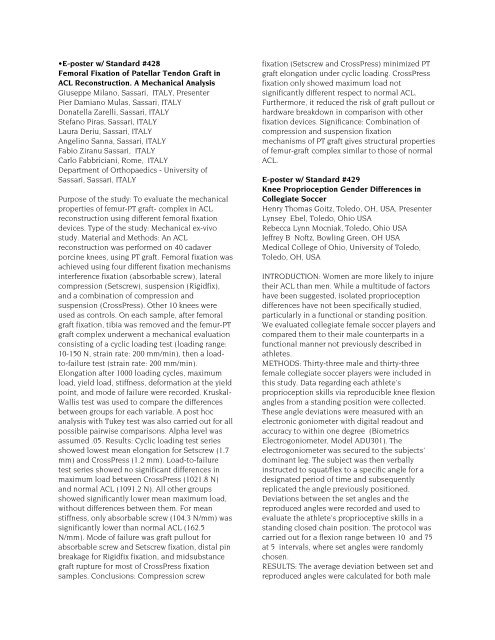POSTER ABSTRACTS - ISAKOS
POSTER ABSTRACTS - ISAKOS
POSTER ABSTRACTS - ISAKOS
Create successful ePaper yourself
Turn your PDF publications into a flip-book with our unique Google optimized e-Paper software.
•E-poster w/ Standard #428<br />
Femoral Fixation of Patellar Tendon Graft in<br />
ACL Reconstruction. A Mechanical Analysis<br />
Giuseppe Milano, Sassari, ITALY, Presenter<br />
Pier Damiano Mulas, Sassari, ITALY<br />
Donatella Zarelli, Sassari, ITALY<br />
Stefano Piras, Sassari, ITALY<br />
Laura Deriu, Sassari, ITALY<br />
Angelino Sanna, Sassari, ITALY<br />
Fabio Ziranu Sassari, ITALY<br />
Carlo Fabbriciani, Rome, ITALY<br />
Department of Orthopaedics - University of<br />
Sassari, Sassari, ITALY<br />
Purpose of the study: To evaluate the mechanical<br />
properties of femur-PT graft- complex in ACL<br />
reconstruction using different femoral fixation<br />
devices. Type of the study: Mechanical ex-vivo<br />
study. Material and Methods: An ACL<br />
reconstruction was performed on 40 cadaver<br />
porcine knees, using PT graft. Femoral fixation was<br />
achieved using four different fixation mechanisms<br />
interference fixation (absorbable screw), lateral<br />
compression (Setscrew), suspension (Rigidfix),<br />
and a combination of compression and<br />
suspension (CrossPress). Other 10 knees were<br />
used as controls. On each sample, after femoral<br />
graft fixation, tibia was removed and the femur-PT<br />
graft complex underwent a mechanical evaluation<br />
consisting of a cyclic loading test (loading range:<br />
10-150 N, strain rate: 200 mm/min), then a loadto-failure<br />
test (strain rate: 200 mm/min).<br />
Elongation after 1000 loading cycles, maximum<br />
load, yield load, stiffness, deformation at the yield<br />
point, and mode of failure were recorded. Kruskal-<br />
Wallis test was used to compare the differences<br />
between groups for each variable. A post hoc<br />
analysis with Tukey test was also carried out for all<br />
possible pairwise comparisons. Alpha level was<br />
assumed .05. Results: Cyclic loading test series<br />
showed lowest mean elongation for Setscrew (1.7<br />
mm) and CrossPress (1.2 mm). Load-to-failure<br />
test series showed no significant differences in<br />
maximum load between CrossPress (1021.8 N)<br />
and normal ACL (1091.2 N). All other groups<br />
showed significantly lower mean maximum load,<br />
without differences between them. For mean<br />
stiffness, only absorbable screw (104.3 N/mm) was<br />
significantly lower than normal ACL (162.5<br />
N/mm). Mode of failure was graft pullout for<br />
absorbable screw and Setscrew fixation, distal pin<br />
breakage for Rigidfix fixation, and midsubstance<br />
graft rupture for most of CrossPress fixation<br />
samples. Conclusions: Compression screw<br />
fixation (Setscrew and CrossPress) minimized PT<br />
graft elongation under cyclic loading. CrossPress<br />
fixation only showed maximum load not<br />
significantly different respect to normal ACL.<br />
Furthermore, it reduced the risk of graft pullout or<br />
hardware breakdown in comparison with other<br />
fixation devices. Significance: Combination of<br />
compression and suspension fixation<br />
mechanisms of PT graft gives structural properties<br />
of femur-graft complex similar to those of normal<br />
ACL.<br />
E-poster w/ Standard #429<br />
Knee Proprioception Gender Differences in<br />
Collegiate Soccer<br />
Henry Thomas Goitz, Toledo, OH, USA, Presenter<br />
Lynsey Ebel, Toledo, Ohio USA<br />
Rebecca Lynn Mocniak, Toledo, Ohio USA<br />
Jeffrey B Noftz, Bowling Green, OH USA<br />
Medical College of Ohio, University of Toledo,<br />
Toledo, OH, USA<br />
INTRODUCTION: Women are more likely to injure<br />
their ACL than men. While a multitude of factors<br />
have been suggested, isolated proprioception<br />
differences have not been specifically studied,<br />
particularly in a functional or standing position.<br />
We evaluated collegiate female soccer players and<br />
compared them to their male counterparts in a<br />
functional manner not previously described in<br />
athletes.<br />
METHODS: Thirty-three male and thirty-three<br />
female collegiate soccer players were included in<br />
this study. Data regarding each athlete's<br />
proprioception skills via reproducible knee flexion<br />
angles from a standing position were collected.<br />
These angle deviations were measured with an<br />
electronic goniometer with digital readout and<br />
accuracy to within one degree (Biometrics<br />
Electrogoniometer, Model ADU301). The<br />
electrogoniometer was secured to the subjects'<br />
dominant leg. The subject was then verbally<br />
instructed to squat/flex to a specific angle for a<br />
designated period of time and subsequently<br />
replicated the angle previously positioned.<br />
Deviations between the set angles and the<br />
reproduced angles were recorded and used to<br />
evaluate the athlete's proprioceptive skills in a<br />
standing closed chain position. The protocol was<br />
carried out for a flexion range between 10 and 75<br />
at 5 intervals, where set angles were randomly<br />
chosen.<br />
RESULTS: The average deviation between set and<br />
reproduced angles were calculated for both male
















